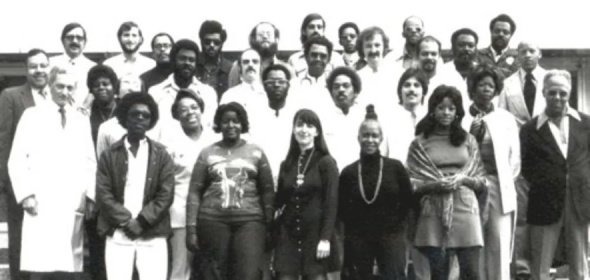By Arthur L. Kellermann, ER doctor, public health researcher and patient advocate. Reprinted with permission from the author.
Pictured above: Freedom House Ambulance Service Group Photo, 1974 (photo courtesy of John Moon)
Certain figures loom large during Black History Month, including Harriett Tubman, W.E.B. Dubois, and Dr. Martin Luther King, Jr. But we should also take time to learn about lesser-known heroes who are frequently overlooked because their deeds were hidden from view. The paramedics of Freedom House Ambulance Service in Pittsburgh, PA, are one such story.
I recently learned of their accomplishments at the annual meeting of the National Association of EMS Physicians (NAEMSP) in Austin, Texas. I was stunned by what I heard.
In 1967 — a time of racial unrest in our country — Pittsburgh’s Hill District, overwhelmingly Black, was poorly served by city government. When community members had a medical emergency, they got a police response instead. Many were denied transport, explained John Moon, retired assistant chief of Pittsburgh EMS, who delivered the meeting’s keynote address.
To meet the Hill District’s needs, a small, biracial group of benefactors and Freedom House Enterprises created America’s first advanced life support ambulance service. For the next seven years, Freedom House Ambulance provided the Hill District with a level of prehospital care that did not exist in any other Pittsburgh neighborhood, or for that matter, the United States.
An EMS1 article published in 2014 described the initial 25 recruits: “Most were unemployed. Some were returning Vietnam war vets struggling with drugs and alcohol. Some were recruited off the streets.” John Moon was among the first to sign up.
Dr. Peter Safer, a University of Pittsburgh anesthesiologist who was nationally renowned as the “Father of CPR,” agreed to provide their training. After his 11-year-old daughter died of an asthma attack, he concluded that lives like hers could be saved if the ambulances of that era were transformed from transport vehicles into mobile treatment centers. He arranged for Freedom House trainees to rotate in local hospital ERs, operating rooms, radiology departments, labor and delivery, and the hospital morgue.
In an interview for EMS1, Moon recalled that Dr. Safer personally taught him how to intubate patients. “I was terrified,” Moon said, “But Safar believed, what better way to train you to do something than under pressure? We went from [O.R.] room to room doing it. If you had taken forever to put a tube down a patient’s trachea, the patient would start moving from a lack of oxygen. So we moved fast.”
The intense training paid off. Later, while serving as a Freedom House paramedic, Moon performed the first out-of-hospital endotracheal intubation in American history. He succeeded on his first attempt.
Once their training was complete, Freedom House initiated service in 1968. In their first year, they responded to almost 5,800 calls and transported more than 4,600 patients to area hospitals. Based on data collected by Dr. Safar, Freedom House paramedics saved 200 lives that year. Each year afterward built on this success.
Unfortunately, the ambulance service was viewed with concern by City Hall. White neighborhoods grew indignant that Hill District residents were receiving better care than them. Rather than allow Freedom House to expand service to other neighborhoods, in 1975 the City of Pittsburgh cut Freedom House’s funding and subsumed its personnel and operations into a newly established citywide EMS service.
In a follow-up interview, Moon described what happened next. “Despite a written agreement that our previous training would be accepted, it was not. As a result of constant belittling and additional needless class sessions, a great number of Freedom House personnel were systematically eliminated from employment with Pittsburgh EMS. When you eliminate the history makers, you essentially eliminate that part of history.”
John Moon persevered, and after 35 years with Pittsburgh EMS, retired at the rank of assistant chief in 2009.
I had not heard Freedom House’s story before Moon’s address in Austin. Worse, as a member of a 2006 National Academy of Medicine committee that issued three reports on “The Future of Emergency Care in the US Health System,” my colleagues and I failed to recognize Freedom House’s pivotal role in the creation of modern EMS.
At a time when affirmative action and DEI are under attack, stories like this one must be told. If deeds this significant can be hidden for decades, how can we fully appreciate the contributions Black Americans make to our nation?
Freedom House offers a compelling example of why increasing diversity in medicine and other health professions benefits patients. One history quotes an observer who remarked, "Freedom House [paramedics] had compassion for the community...They told me when you walk into a person’s home, you’re a guest. That’s the number one thing they brought to the table: They cared. They addressed everybody by their names. They respected them and asked permission before providing treatment."
Freedom House Ambulance Service is an inspiring story for our nation. It is also a cautionary tale. Fifty years on, I hope the brave 25 who stepped up to serve Pittsburgh’s Hill District finally get their due. Their groundbreaking work not only saved lives; it opened the modern era of EMS for our nation and the world. May their story, and others like it, bend the arc of history toward justice.
Readers are urged to watch “Freedom House Ambulance: The FIRST Responders,” a remarkable 30-minute WQED documentary, or a 3.5-minute trailer to an earlier documentary entitled, “Freedom House: Street Saviors.”
Healthforce Center shares this story to celebrate Black History Month. See our related research, Characteristics of California’s EMT and Paramedic Workforce.
